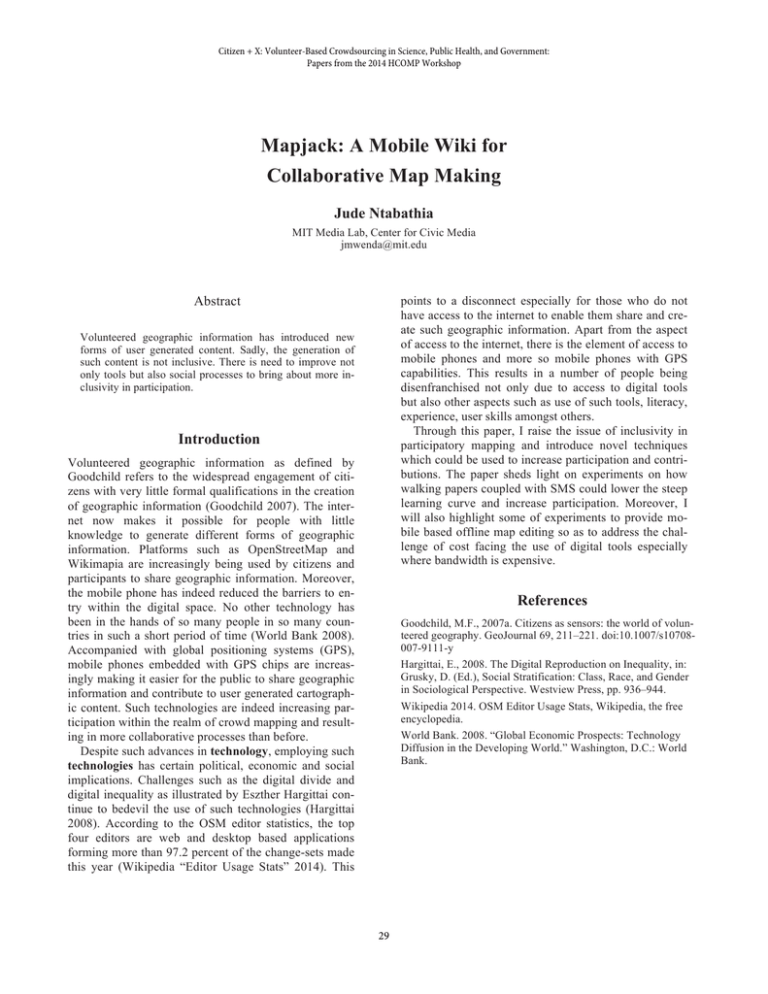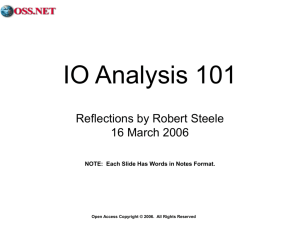Mapjack: A Mobile Wiki for Collaborative Map Making Jude Ntabathia
advertisement

Citizen + X: Volunteer-Based Crowdsourcing in Science, Public Health, and Government: Papers from the 2014 HCOMP Workshop Mapjack: A Mobile Wiki for Collaborative Map Making Jude Ntabathia MIT Media Lab, Center for Civic Media jmwenda@mit.edu Abstract points to a disconnect especially for those who do not have access to the internet to enable them share and create such geographic information. Apart from the aspect of access to the internet, there is the element of access to mobile phones and more so mobile phones with GPS capabilities. This results in a number of people being disenfranchised not only due to access to digital tools but also other aspects such as use of such tools, literacy, experience, user skills amongst others. Through this paper, I raise the issue of inclusivity in participatory mapping and introduce novel techniques which could be used to increase participation and contributions. The paper sheds light on experiments on how walking papers coupled with SMS could lower the steep learning curve and increase participation. Moreover, I will also highlight some of experiments to provide mobile based offline map editing so as to address the challenge of cost facing the use of digital tools especially where bandwidth is expensive. Volunteered geographic information has introduced new forms of user generated content. Sadly, the generation of such content is not inclusive. There is need to improve not only tools but also social processes to bring about more inclusivity in participation. Introduction Volunteered geographic information as defined by Goodchild refers to the widespread engagement of citizens with very little formal qualifications in the creation of geographic information (Goodchild 2007). The internet now makes it possible for people with little knowledge to generate different forms of geographic information. Platforms such as OpenStreetMap and Wikimapia are increasingly being used by citizens and participants to share geographic information. Moreover, the mobile phone has indeed reduced the barriers to entry within the digital space. No other technology has been in the hands of so many people in so many countries in such a short period of time (World Bank 2008). Accompanied with global positioning systems (GPS), mobile phones embedded with GPS chips are increasingly making it easier for the public to share geographic information and contribute to user generated cartographic content. Such technologies are indeed increasing participation within the realm of crowd mapping and resulting in more collaborative processes than before. Despite such advances in technology, employing such technologies has certain political, economic and social implications. Challenges such as the digital divide and digital inequality as illustrated by Eszther Hargittai continue to bedevil the use of such technologies (Hargittai 2008). According to the OSM editor statistics, the top four editors are web and desktop based applications forming more than 97.2 percent of the change-sets made this year (Wikipedia “Editor Usage Stats” 2014). This References Goodchild, M.F., 2007a. Citizens as sensors: the world of volunteered geography. GeoJournal 69, 211–221. doi:10.1007/s10708007-9111-y Hargittai, E., 2008. The Digital Reproduction on Inequality, in: Grusky, D. (Ed.), Social Stratification: Class, Race, and Gender in Sociological Perspective. Westview Press, pp. 936–944. Wikipedia 2014. OSM Editor Usage Stats, Wikipedia, the free encyclopedia. World Bank. 2008. “Global Economic Prospects: Technology Diffusion in the Developing World.” Washington, D.C.: World Bank. 29

